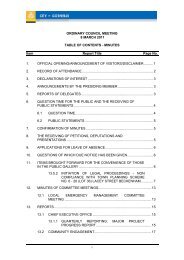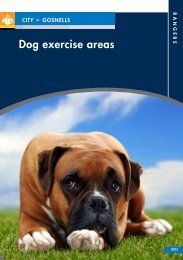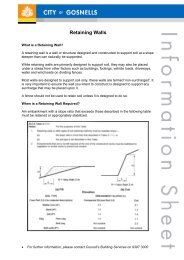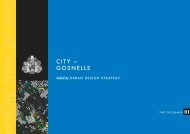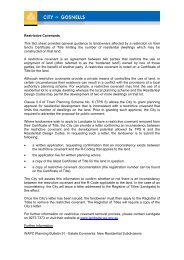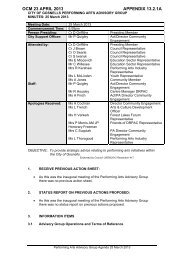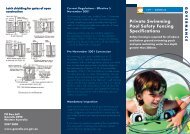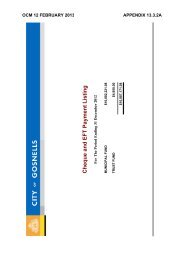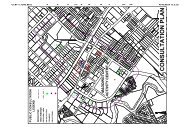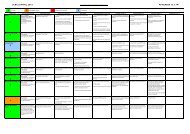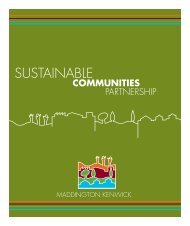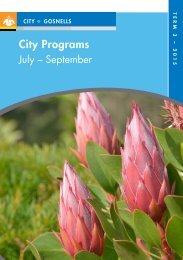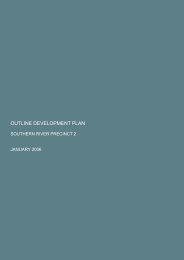Summary - City of Gosnells
Summary - City of Gosnells
Summary - City of Gosnells
You also want an ePaper? Increase the reach of your titles
YUMPU automatically turns print PDFs into web optimized ePapers that Google loves.
Flora 42Eremophila glabra subsp. chlorella was previously confused with another subspecies <strong>of</strong>, butEremophila glabra subsp. chlorella is now known to be extremely rare (R.J. Chinnock and G.J.Keighery, pers. comms.). Apart from the occurrence in the MKSEA, the only other occurrence <strong>of</strong>Eremophila glabra subsp. chlorella on the SCP appears to be in one small suburban degraded bushremnant (B.J. & G.J. Keighery pers. comms.).Active recovery measures are urgently needed to prevent the extirpation <strong>of</strong> Eremophila glabra subsp.chlorella on the SCP.2. Schoenus pennisetis (Cyperaceae) (Priority 1). This is inconspicuous annual sedge that is usually lessthan 10 cm in height. This sedge was present in a number <strong>of</strong> blocks in scrub, heath and sedgelands onpalusplain and in sumplands.3. Lepyrodia curvescens ms (Restionaceae) (Priority 2). This is a dioecious, tufted, shortly rhizomatousrush 0.24–0.4 m in height. The rhizomes are at, or very near, the soil surface and are glabrous and palebrown. This species is poorly known and probably poorly collected. It is most similar to Lepyrodiahermaphrodita and L. monoica but is dioecious, has appressed culm sheaths and a longer leaf lamina. Itcan be distinguished from L. macra by its sparser inflorescence and appressed culm sheaths. Lepyrodiacurvescens is infrequent on peaty sand and shallow sand over ‘laterite’ (Western Australian Herbarium,2009) on the margins <strong>of</strong> wetlands and in seasonally waterlogged basins. It flowers between Septemberand November. It has been recorded previously in Marri woodland near Jurien, wetland heath nearMogumber and in Eucalyptus todtiana woodland and Marri-Kingia woodland at Hazelmere in theDarling Range Foothills. The occurrence in the MKSEA (in Marri-Kingia woodland) is a southern rangeextension for this species. From FloraBase descriptions (Western Australian Herbarium, 2009) itappears that occurrences <strong>of</strong> Lepyrodia curvescens in Hazelmere were recorded from habitats(Bassendean Sands overlying the Guildford Formation in close proximity to the Darling RangeFoothills) similar to some <strong>of</strong> those in the MKSEA.4. Trichocline sp. Treeton (B.J. Keighery & N. Gibson 564) (Asteraceae) (Priority 2). This perennialherb has narrow glabrous leaves and a large inflorescence <strong>of</strong> white and pink ray florets, similar to themore common Trichocline spathulata. It was recorded on two blocks in the MKSEA, amongst shrubson palusplain.5. Baeckea sp. Perth Region R.J. Cranfield 444 (Myrtaceae) (Priority 3). This wispy shrub, less thanabout 1 m in height, is <strong>of</strong>ten overlooked or mistaken for a species <strong>of</strong> Astartea or Verticordia. It wasrecorded on five blocks in the MKSEA on palusplain in dense heath or sedgelands.6. Cyathochaeta teretifolia (Cyperaceae) (Priority 3). This rhizomatous perennial sedge grows to about 1m or more in height and has culms that are round to broadly elliptical in cross-section. It is generallyfound in peaty sumplands that are maintained by uncommon hydrological factors. Cyathochaetateretifolia inhabits a number <strong>of</strong> locations in the Warren and Jarrah Forest Bioregions, including thefringes <strong>of</strong> tributaries <strong>of</strong> the Blackwood River that are maintained by the deep Yarragadee andLeederville aquifers. However, the habitat <strong>of</strong> Cyathochaeta teretifolia is very uncommon on the SCP.Records <strong>of</strong> this species on the SCP are predominantly from collections made many decades ago fromwetlands where the hydrological conditions and vegetation are now completely degraded.A closed sedgeland <strong>of</strong> Cyathochaeta teretifolia was recorded in this survey in a wetland that wasassessed as having very high conservation significance. It is probably the only permnanentlywaterlogged wetland in the vicinity <strong>of</strong> the Greater Brixton Street Wetlands where the vegetation remainsmore or less intact.7. Calothamnus rupestris (Myrtaceae) (Priority 4). This is a tall shrub with red flowers and needle-like,pungent leaves. It also appeared to have been planted in an additional site adjacent to Yule Brook.Calothamnus rupestris is uncommon on the Swan Coastal Plain; it is generally confined to granite andlaterite habitats along creeks in the Darling Range and the Darling Scarp (mainly in the Perth Region).8. Grevillea thelemanniana (Proteaceae) (Priority 4). This attractive low or prostrate shrub was recordedon palusplain in several blocks in the MKSEA. Although this shrub is relatively common in the GreaterBrixton Street Wetlands it is a very narrowly-endemic species entirely confined to the Kenwick area.Tauss, C. and Weston, A.S. (2010). The flora, vegetation and wetlands <strong>of</strong> the Maddington-Kenwick Strategic Employment Area.A survey <strong>of</strong> the rural lands in the vicinity <strong>of</strong> the Greater Brixton Street Wetlands. Report to the <strong>City</strong> <strong>of</strong> <strong>Gosnells</strong>, W.A. Version 18.04.10



